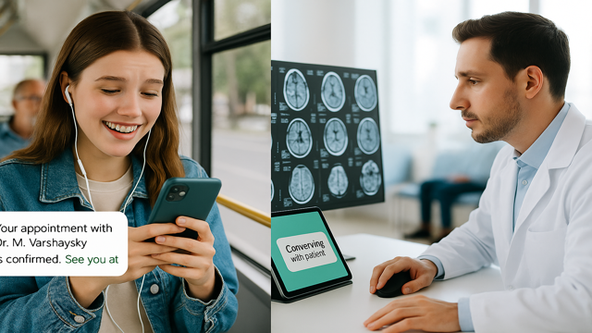6 min read
Automate Your Front Desk: Patient Scheduling with Conversational AI
Gregory Vic Dela Cruz : 8/8/25 3:00 PM

On the surface, scheduling patients might look like a basic administrative task. But for many small clinics, it's often perceived as a permanent struggle. Limited staff, high call volumes, and manual scheduling processes lead to inefficiencies and frustrated patients.
This blog explores how conversational AI is transforming healthcare workflow management for small practices. We’ll highlight common scheduling challenges, introduce AI-powered solutions, and show how automation can drastically improve efficiency, reduce no-shows, and enhance the patient experience.
If your clinic is drowning in phone calls and appointment delays, it’s a perfect time to consider process improvements. Eager to see how smart scheduling systems like AI chatbots can streamline your workflow? Let’s jump right in.
Why Healthcare Workflow Management for Small Clinics Needs a Tech Upgrade
The Realities of Running a Small Practice
In a small clinic, every team member plays multiple roles. Receptionists handle phones, patient intake, insurance verification, and follow-ups—often all at once. This multitasking makes manual processes vulnerable to errors and inefficiencies.
How Workflow Management Helps
Effective healthcare workflow management for small clinics involves creating systems that reduce redundant tasks and improve overall coordination. Digital solutions like conversational AI and scheduling software allow clinics to automate repetitive actions such as appointment confirmations, reminders, and check-in procedures.
Key benefits of digital workflow management include:
- Streamlined appointment booking without the need for manual calls
- Faster patient check-ins with automated forms and digital intake
- Improved staff productivity through clearer task delegation
- Enhanced patient satisfaction with shorter wait times and better communication
As patient demand increases and staffing challenges persist, a well-managed workflow isn’t just a nice-to-have—it’s essential. And the entry point for many clinics? Smart scheduling powered by AI.
The Struggle with Manual Scheduling in Clinics
Manual Scheduling: An Outdated Burden
According to a survey conducted by The HIPAA Journal, 43% of organizations still rely on manual processes. Manual scheduling continues to be one of the most inefficient, error-prone processes in many small clinics. While it may seem manageable on the surface, the cracks become more evident as patient volume increases. Clinics that still rely on phone calls, paper calendars, or basic EMR appointment modules experience operational friction that can ripple throughout the entire patient experience.
Let’s break down seven common pain points that plague manual scheduling systems:
1. Hidden Costs of Human Error
When staff manually enter appointments or rely on memory to confirm changes, mistakes happen. Double bookings, missed time slots, and forgotten follow-ups can result in wasted provider time and patient dissatisfaction—both of which come at a financial cost.
2. Long Hold Times and Phone Tag
Patients often have to wait on hold or call multiple times to find an available slot. Staff are frequently interrupted by phone calls, slowing down front-desk operations and increasing the risk of errors.
3. High No-Show Rates
Without a system for sending automated reminders or confirmations, patients are more likely to forget their appointments. Manual systems often lack the follow-up mechanisms to reduce no-shows effectively, impacting both care continuity and revenue.
4. Limited Hours for Booking
Manual scheduling depends entirely on staff availability. If a patient wants to book an appointment at 10 p.m., they’ll likely wait until the next day—or abandon the idea altogether. This results in lost opportunities.
5. Lack of Real-Time Updates
Schedules are frequently out of sync when clinics use a whiteboard, Excel sheet, or even basic EMR appointment screens. Providers may not be informed of last-minute changes, which creates inefficiencies and frustration.
6. Inconsistent Patient Communication
Appointment confirmations, reminders, or prep instructions can be skipped or inconsistently delivered, especially if handled manually. This leads to patient confusion or missed steps that affect the visit’s success.
7. Staff Burnout and Admin Overload
Clinic staff spend valuable hours each week handling tasks that could be automated—calling patients, confirming appointments, rescheduling missed ones, and reminding patients of upcoming visits. This repetitive administrative burden contributes to high staff turnover and lower morale.
In small clinics where staffing is already lean, these pain points snowball into larger issues, from frustrated patients to decreased revenue. The solution? Shift from reactive manual scheduling to proactive, AI-powered appointment management. In the next section, we’ll explore real-life use cases of how AI appointment booking for clinics can solve these challenges.

How AI Appointment Booking for Clinics Makes an Impact
Case Study 1: A Small Outpatient Clinic Transforms Front Desk Efficiency
In many small outpatient clinics, the front desk team is responsible for managing everything from incoming calls to appointment coordination and insurance verification. With only a few team members handling high volumes of daily interactions, scheduling often becomes reactive and rushed—leading to long hold times, missed follow-ups, and patient frustration.
One such clinic decided to implement an AI-powered appointment booking solution to address the growing workload. Patients could now schedule appointments through a website chatbot or SMS interface, available 24/7. The AI system used natural language processing (NLP) to understand patient intent and offered relevant times based on provider availability and appointment type.
After integrating the system:
- Front desk staff were able to reallocate time from answering routine scheduling calls to assisting in-clinic patients.
- Patients appreciated the convenience of booking appointments outside of office hours without needing to wait on hold.
- The scheduling process became more accurate, reducing last-minute confusion and double-bookings.
The shift to AI appointment booking significantly reduced manual effort and improved both staff productivity and the patient experience.
Case Study 2: A Multi-Provider Practice Improves Scheduling Accuracy
Multi-provider clinics often face complex scheduling needs. Each provider may have different availability, appointment types, or patient preparation requirements. In one such clinic, scheduling staff frequently spent extra time on back-and-forth communication with patients to ensure the right appointment fit with the right provider—often leading to errors or delays.
By introducing an AI appointment booking tool that integrated with their EMR, the clinic streamlined this process. The AI tool was configured to intelligently route patients to the correct provider based on inputs like reason for visit, language preference, and appointment urgency.
The benefits included:
- Reduction in misbooked appointments due to AI-driven logic and preset parameters.
- Improved patient satisfaction thanks to faster booking and accurate confirmation messaging.
- Fewer follow-up calls needed to clarify appointment details, freeing up staff time.
Through automation, the clinic was able to support its growing patient base without hiring additional administrative staff. This made a significant difference in how quickly and confidently patients were scheduled, especially during peak times.
These scenarios highlight how AI appointment booking tools are more than just a convenience—they are a scalable solution to everyday scheduling challenges. In the next section, we’ll look at how automated patient scheduling software like Curogram enhances this system even further through additional workflow automation.
Automated Patient Scheduling Software: A Seamless Experience with Curogram
What Makes Curogram’s Solution Stand Out
Among the growing list of digital tools, Curogram's automated patient scheduling software is purpose-built for clinics needing simplicity and power. It combines HIPAA compliance, EMR integration, and patient messaging into a single, easy-to-use platform.
Key Features Include:
- Real-time sync with major EMRs
- Custom appointment workflows by provider, location, or visit type
- Built-in reminder sequences via text, email, or voice
How Automation Helps Staff
Clinic staff can now focus on in-office patients while the system handles inbound appointment requests. Missed call follow-ups, reminder messages, and even pre-visit prep instructions are sent automatically—saving hours of admin work weekly.
Impact on No-Show Rates
Curogram clients report significant reductions in no-shows thanks to pre-visit reminders and real-time rescheduling features. This translates directly to more revenue and better patient outcomes.
Ready to stop juggling calendars and start automating patient flow? Curogram gives you the tools to do just that.
Chatbot for Healthcare Scheduling: The Future of Patient Engagement
Why Chatbots Are Ideal for Clinics
Healthcare-specific chatbots go beyond basic Q&A—they integrate with your systems, understand medical terminology, and guide patients through complex scheduling workflows. Unlike generic chat tools, these bots are trained specifically for medical use cases.
Core Functions of a Healthcare Chatbot
- Greeting patients and asking for their reason for visit
- Offering appointment slots based on provider availability
- Answering FAQs around insurance, location, or hours
- Routing urgent inquiries to live staff
How Curogram Powers Its Chatbot
Curogram’s chatbot functionality empowers clinics to capture more appointments from their websites, after-hours inquiries, or missed calls. The bot can:
- Initiate SMS-based scheduling flows after a missed call
- Redirect to human agents when specific input is needed
- Work within HIPAA guidelines for secure communications
Your practice can benefit from this AI-powered technology instantly. With Curogram's Online Chat Request, you can have patients—both existing and potential—start a conversation directly through your website. Not only does this feature relieve workload from your front desk operator, but it becomes a gateway for visitors to discover your practice online.
See visitors of your practice's website or social media page become actual patients.
Chatbots aren’t just an add-on—they’re a frontline digital receptionist that never sleeps. And for small clinics, they’re a competitive edge that boosts patient satisfaction while freeing up staff time.
Conclusion: Meet Patient Expectations Through Modernized Clinic Scheduling
Manual scheduling doesn’t scale. As patient expectations rise and clinic staff stretch thinner, automation and AI become not just helpful, but essential. Conversational AI tools—like chatbots, AI appointment booking, and automated reminders—integrate perfectly with healthcare workflow management for small clinics.
Solutions like Curogram bring together patient engagement, scheduling, EMR syncing, and automation in one HIPAA-compliant platform. Whether you're trying to reduce no-shows or streamline operations, it's time to make the shift.
Want to see how Curogram can transform your clinic? Request a free demo today.

The Future of Care: How AI Patient Engagement is Revolutionizing the Patient Experience
AI patient engagement is the use of artificial intelligence technologies to actively involve and empower patients throughout their own healthcare...

The Small Practice Guide to Conversational AI in Healthcare
With breakthroughs in healthcare tech, especially with the use of AI, patients now expect faster and more personalized communication from their...

